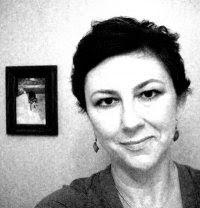Well, it's mid-term, and here's a little round up of some student work from my watercolor class---you guys have come a long way!!!
Wednesday, March 12, 2008
Mint Museum Portrait class Day 3 Student Work
Portrait Painting at the Mint: Day Three
Today’s class will offer a slightly different approach and another traditional technique. We will focus on value today, and color during class 4. Do not worry about warm and cool today---only value. You will only use three colors for today’s exercise: burnt sienna, ultramarine blue and white. You will be surprised by how much you can do with just these three colors.
Step One: I begin with a transparent monochrome as in Day One. Keep the paint thin and washy.
Step Two: I add ultramarine blue to my burnt sienna to create a darker value. Then I paint in the shadow on my model. I add a value to my negative space (background). My paint has a little more body than in Step One, but not heavy.
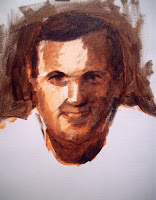
Step Three: I add a touch of white to some burnt sienna, and paint in the mid tones. I use a dry brush to blend tones a little; but try to not over blend at this point. I’ll actually be covering a lot of this up in later steps. However, since I will be glazing color over this, I don’t want my surface to have a lot of ridges. It will catch the glazes and make streaks on my painting.
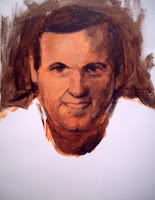
Step Four: I mix a lighter value using burnt sienna and white and paint in areas of light. I redraw as needed at any step along the way. For example, one ear was considerably higher than the other….Again, I may use a dry brush to blend a little if desired. Occasionally I like to pretend I’m Leonardo da Vinci and smear a little with my thumb or fingers, but somehow it never measures up….I just keep trying.
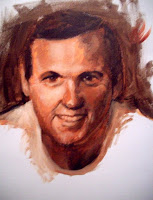
Step Five: I mix an even lighter version of burnt sienna and white and painting in highlights. I also refine tones in between.
Remember to look for the six categories of light as listed in your Day One handout:
1. Highlight: (nose, brow bone, cheek on my model)
2. Light: (turn of the cheek, forehead)
3. Shadow: (side of the nose, side of the face)
4. Core of Shadow: (right side of cheek, nose, under eyebrows)
5. Reflected Light: (right edge of jaw, neck)
6. Cast Shadow: (under nose, neck)
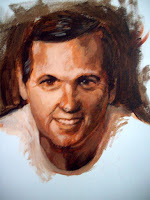
Helpful Hints: Always work from general tones to more specific ones. For example, don’t get caught up in details like the eyelids until you’ve created a general pattern of light and dark. I always start with the three basics: shadow, midtone (or halftone) and light, then refine from there.
Next week we will focus on adding color and color temperature to the underpainting created today
Step One: I begin with a transparent monochrome as in Day One. Keep the paint thin and washy.
Step Two: I add ultramarine blue to my burnt sienna to create a darker value. Then I paint in the shadow on my model. I add a value to my negative space (background). My paint has a little more body than in Step One, but not heavy.

Step Three: I add a touch of white to some burnt sienna, and paint in the mid tones. I use a dry brush to blend tones a little; but try to not over blend at this point. I’ll actually be covering a lot of this up in later steps. However, since I will be glazing color over this, I don’t want my surface to have a lot of ridges. It will catch the glazes and make streaks on my painting.

Step Four: I mix a lighter value using burnt sienna and white and paint in areas of light. I redraw as needed at any step along the way. For example, one ear was considerably higher than the other….Again, I may use a dry brush to blend a little if desired. Occasionally I like to pretend I’m Leonardo da Vinci and smear a little with my thumb or fingers, but somehow it never measures up….I just keep trying.

Step Five: I mix an even lighter version of burnt sienna and white and painting in highlights. I also refine tones in between.
Remember to look for the six categories of light as listed in your Day One handout:
1. Highlight: (nose, brow bone, cheek on my model)
2. Light: (turn of the cheek, forehead)
3. Shadow: (side of the nose, side of the face)
4. Core of Shadow: (right side of cheek, nose, under eyebrows)
5. Reflected Light: (right edge of jaw, neck)
6. Cast Shadow: (under nose, neck)

Helpful Hints: Always work from general tones to more specific ones. For example, don’t get caught up in details like the eyelids until you’ve created a general pattern of light and dark. I always start with the three basics: shadow, midtone (or halftone) and light, then refine from there.
Next week we will focus on adding color and color temperature to the underpainting created today
Subscribe to:
Comments (Atom)


















